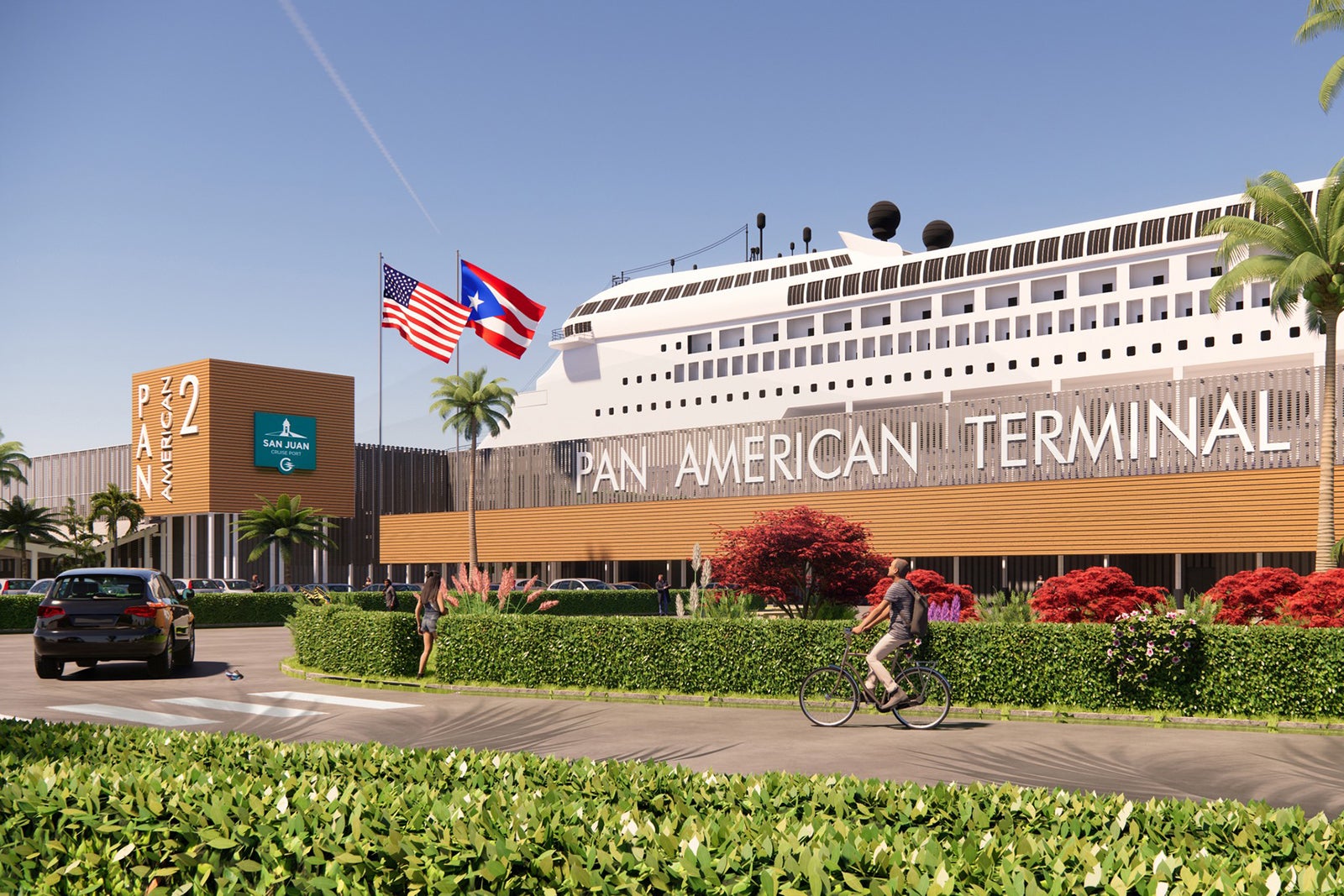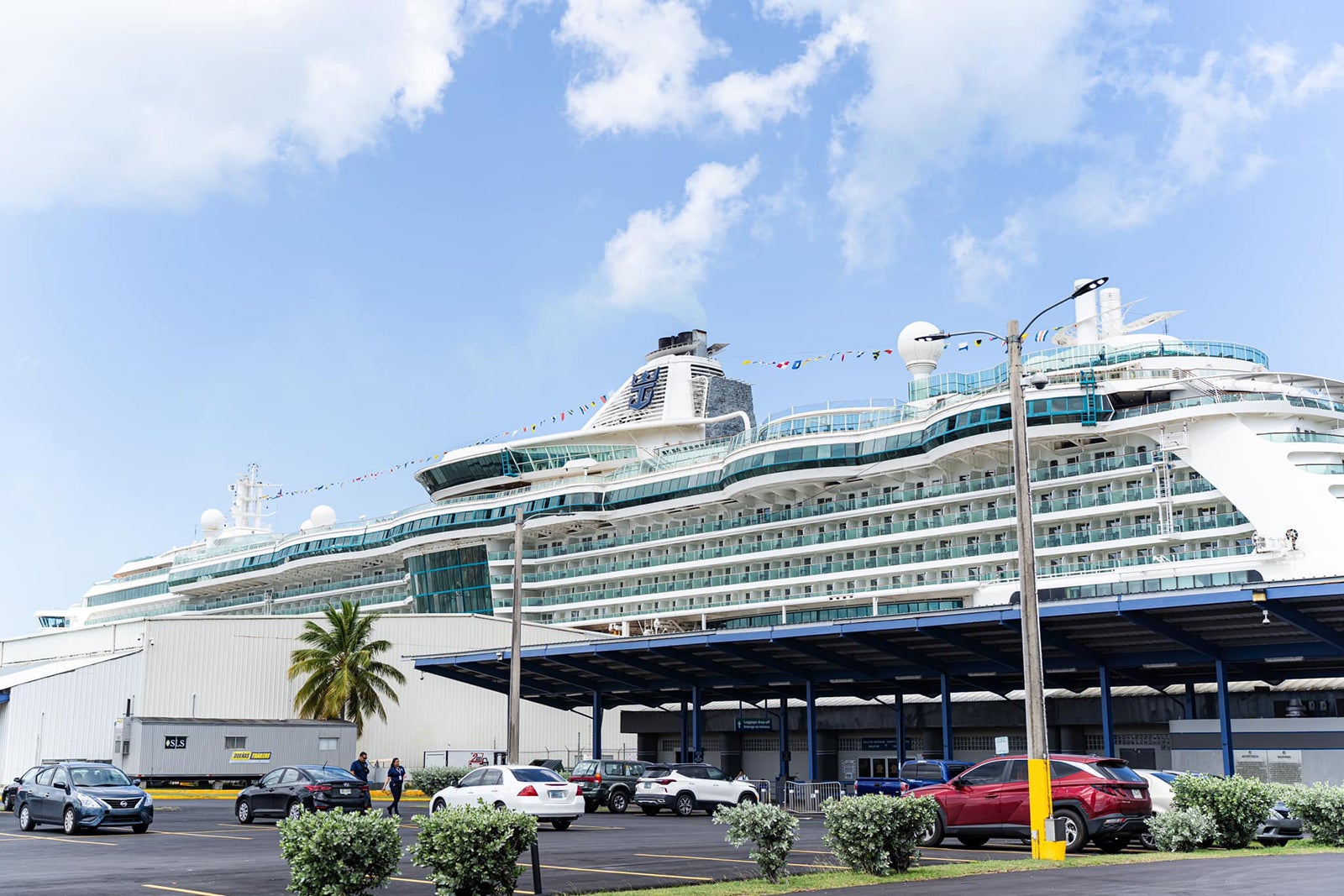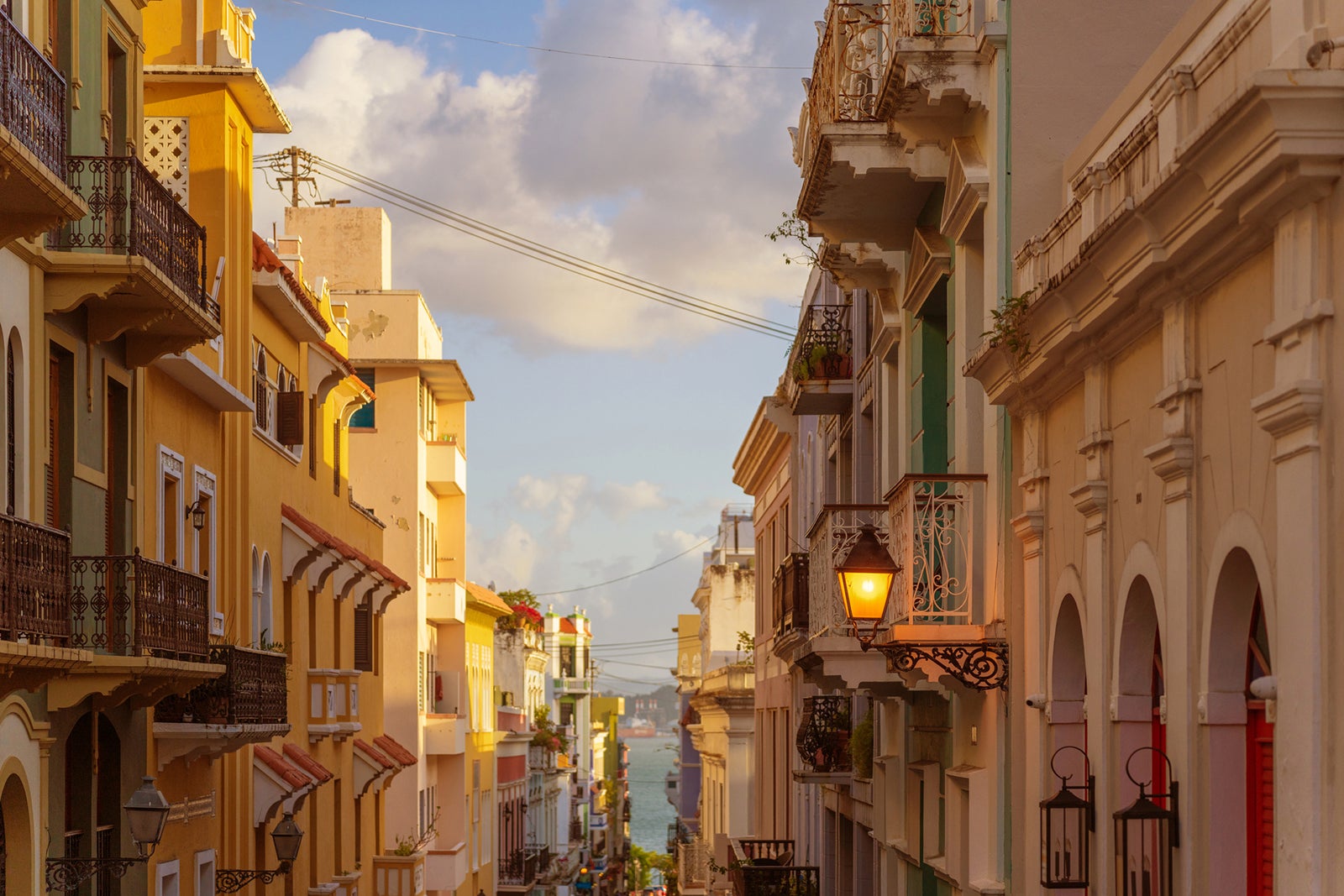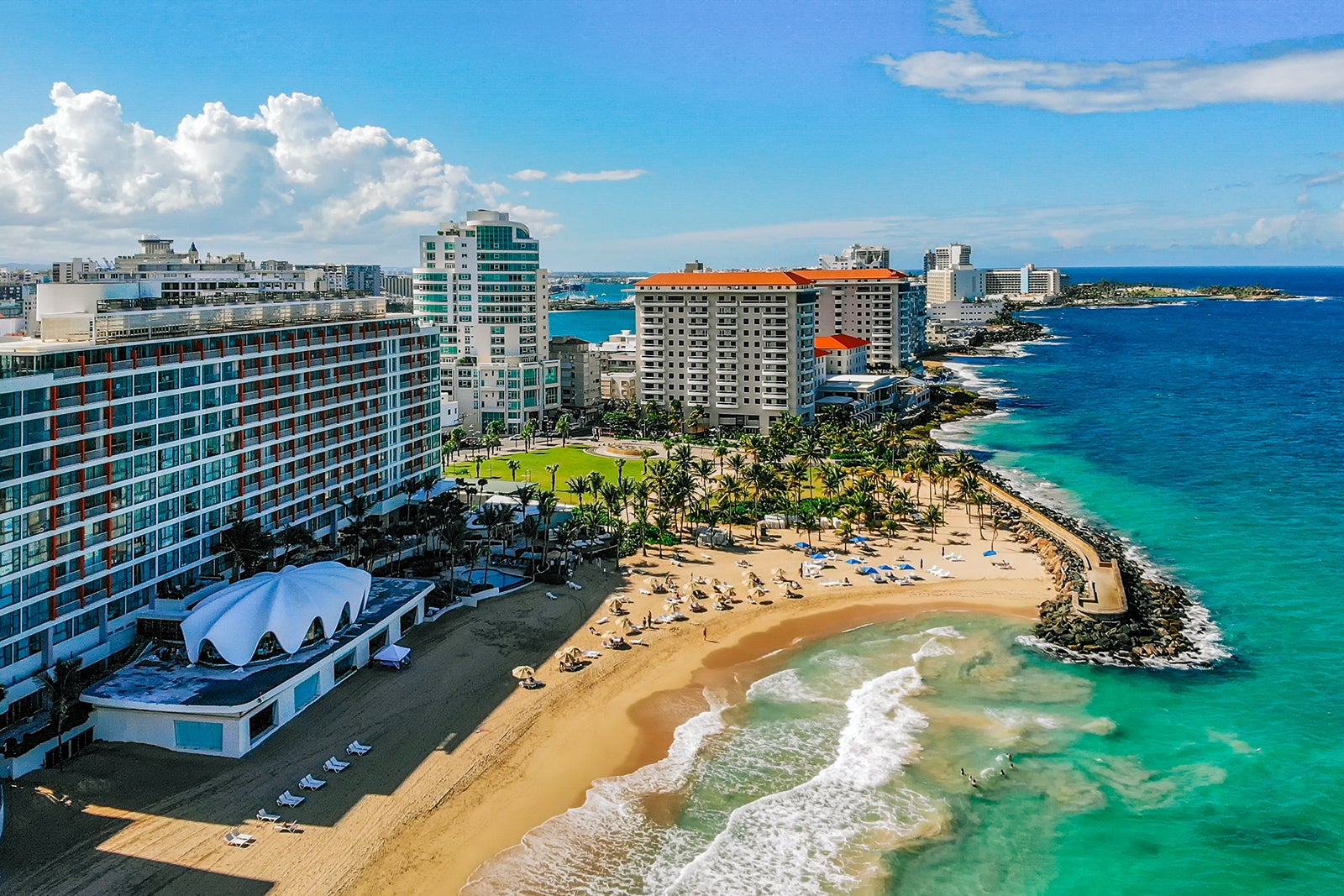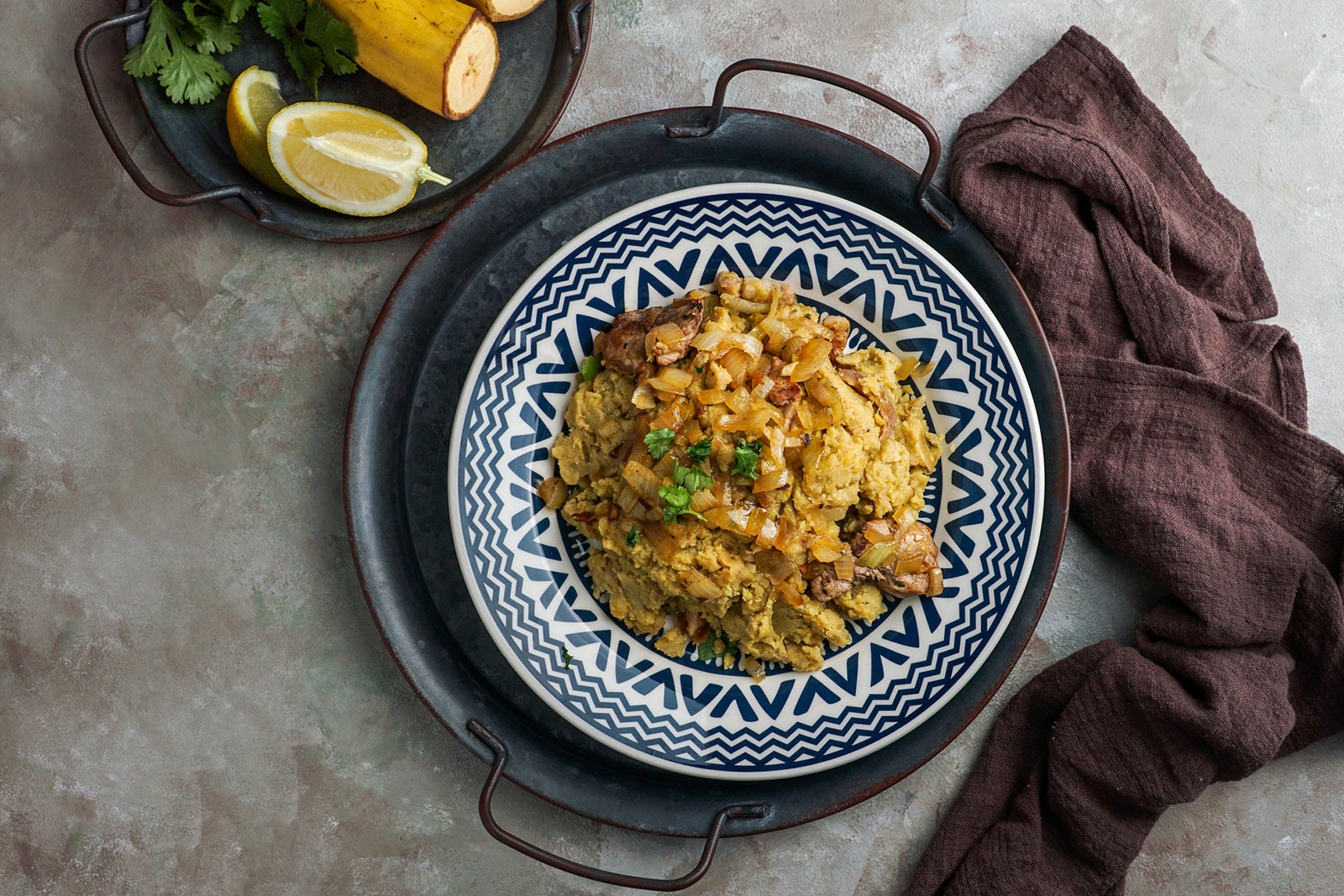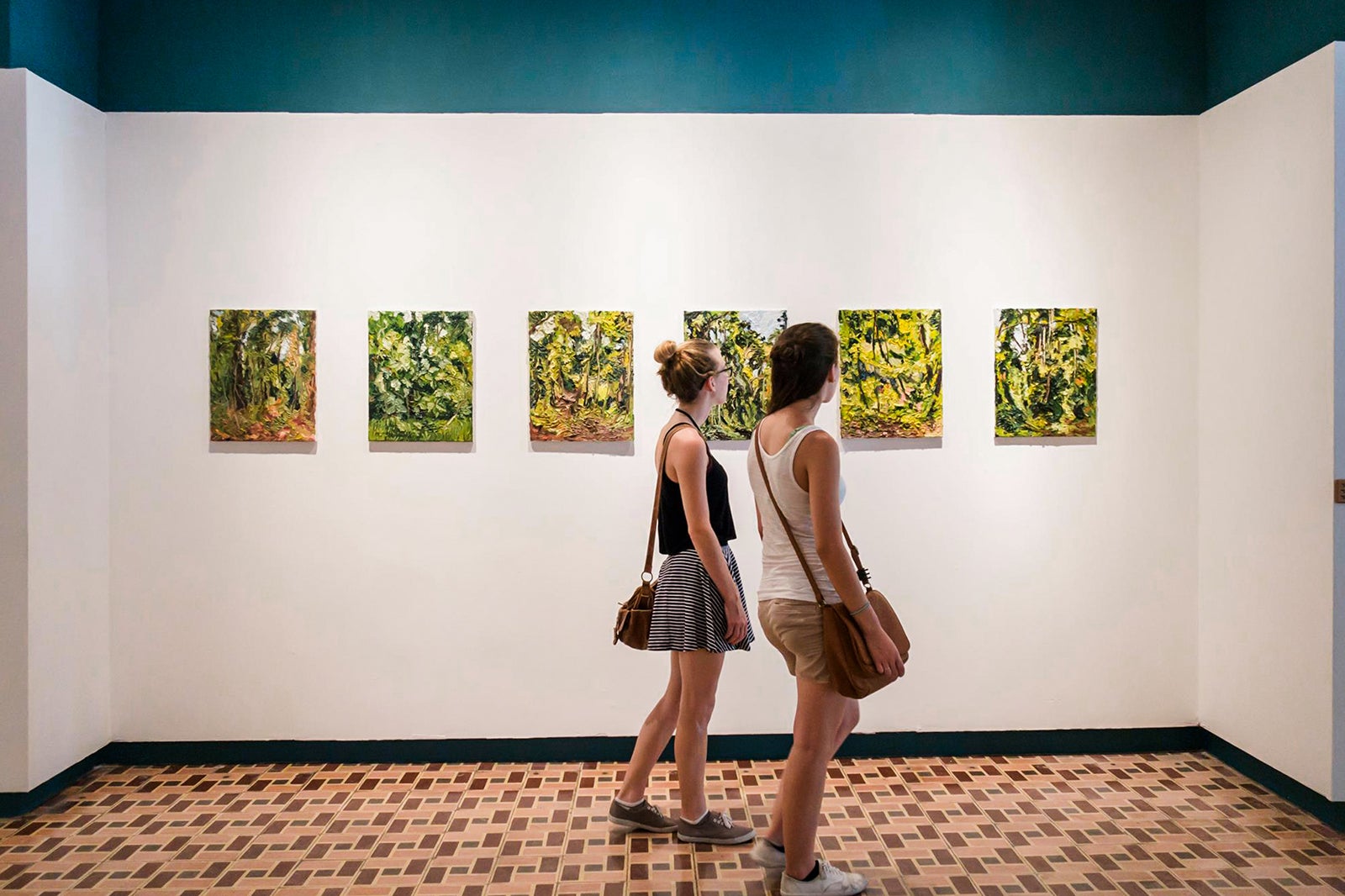Puerto Rico offers a host of lures for cruise travelers — rich history, stunning beaches, natural beauty and fantastic cuisine among them. The island’s capital city, San Juan, is a popular port of call for a variety of operators, including Carnival Cruise Line, Celebrity Cruises, Royal Caribbean, Holland America, Princess Cruises, Norwegian Cruise Line, MSC Cruises and Crystal.
Additionally, San Juan is a departure port for several cruise lines. Royal Caribbean, Viking, Virgin Voyages, Norwegian and Princess sail round-trip itineraries from San Juan. Cruisers who embark in Puerto Rico‘s capital city will likely fly into Luis Munoz Marin International Airport (SJU), 3 miles southeast of downtown in the neighborhood of Isla Verde. There are frequent, daily connections from the U.S., Canada and Europe. The airport is about 7 miles from the cruise port (or about a 15-minute drive).
San Juan is a modern metropolis with upscale dining and shopping. Its numerous attractions make arriving a day or two early a rewarding option for travelers whose ships home port in the city. Points and miles hotels near the San Juan cruise port are plentiful, too. Caribe Hilton, Residence Inn San Juan Isla Verde, Aloft San Juan and San Juan Marriott Resort & Stellaris Casino are a few to consider.
If your next Caribbean cruise adventure stops at the San Juan cruise port, let this be your guide for how to spend your day ashore.
San Juan cruise port overview
3 things TPG loves about the San Juan cruise port
- A walkable historic district
- Delicious local cuisine and a thriving rum scene
- Rich cultural attractions from 500-year-old forts and structures to art and history museums
What we could do without
- Although the historic district is walkable, cobblestone streets and narrow sidewalks make it challenging for those with mobility issues.
- Old San Juan can be crowded in peak cruise season.
San Juan cruise port fast facts
Arrival details
The San Juan cruise port is one of the Caribbean’s busiest. The port can accommodate up to nine ships a day and often hosts at least seven at once per day.
The Old San Juan Piers are at Marina Street, at the center of the historic district. The cruise port is within easy walking distance to many of the city’s significant historic and cultural sites, including the iconic San Felipe del Morro fort (commonly known as El Morro). The port features modern terminal buildings, and passengers will find tours and transportation staged nearby.
Pier 1 is used by Azamara, Windstar Cruises, Silversea Cruises and Seabourn.

Daily Newsletter
Reward your inbox with the TPG Daily newsletter
Join over 700,000 readers for breaking news, in-depth guides and exclusive deals from TPG’s experts
Pier 3 mainly serves Royal Caribbean and its enormous Oasis Class ships. Norwegian, Virgin, Oceania Cruises and Regent Seven Seas Cruises also dock here. The terminal features a two-story complex that houses restaurants, galleries and a duty-free shopping center.
Pier 4 is used and managed by Carnival Cruise Line, but MSC Cruises and Holland America also dock here.
San Juan’s Pan American Pier is situated south of the Old San Juan district of Isla Grande and mainly serves larger cruise vessels of lines like Princess Cruises, Celebrity and Disney Cruise Line. It’s about a 10- to 15-minute drive to or from Old San Juan, so you’ll want to take a taxi or cruise line shuttle (if provided).
Most ships call at the port for up to eight hours, giving cruisers time to explore several Puerto Rico highlights. Ships arrive in San Juan as early as 7 a.m. and sail late in the evening.
Ships that home port in San Juan typically depart as late as 7 or 8 p.m. If you’re taking a round-trip sailing that leaves from San Juan, check your cruise line’s boarding documents to confirm which pier you’ll need to get to on embarkation day.
Languages: Spanish and English
Currency: U.S. dollar
Time zone: Puerto Rico uses Eastern Standard Time. It does not observe daylight saving time.
Related: The best Caribbean cruise for every type of traveler
Top things to do in San Juan cruise port
Puerto Rico’s historic capital of San Juan offers cruisers a wide selection of port call diversions. Much of San Juan’s interesting historical sites and museums are near the cruise port, including San Cristobal and El Morro forts, La Fortaleza and the Cathedral of St. John the Baptist. Additionally, tons of locally owned shops, galleries, cafes and restaurants await visitors.
You’ll also find a bevy of bars, restaurants, craft shops and boutiques within San Juan’s Condado and Isla Verde districts. The Condado neighborhood is less than a 10-minute taxi drive from the cruise port, while Isla Verde is about 15 minutes away. Here are a few ways cruisers can spend their day exploring San Juan.
Old San Juan walking tour
You don’t have to be a history buff to enjoy the more than 500-year-old walled city of Old San Juan. Its rainbow-hued Spanish colonial architecture, towering forts that overlook the Caribbean Sea and charming cobblestone streets beg exploration. The city is replete with attractions worth exploring either on your own or through a guided tour.
The historic district is fairly compact, so you can make the most of your DIY walking tour without rushing. Additionally, you can use your phone’s GPS or Google Maps if you need to. Puerto Rico is a U.S. territory, so phone service from most major U.S. carriers works here (and American visitors don’t need an international plan to make calls).
You can easily fill your time in port with visits to forts like the abovementioned San Cristobal and El Morro. Both are part of the 27-acre San Juan National Historic Site, which also includes Fort Saint John of the Cross and most of the city walls. In addition to providing spectacular views of both the city and sea, highlights here include cannon rooms, a bunker, a dungeon, a plaza, an extensive tunnel system and two observation posts that were added during World War II. Entrance cost is $10 per person, and children 15 and younger are admitted free.
While you’re by the fort, make use of the breezes and expansive lawn at El Morro to fly a kite. Didn’t pack one? No problem. Many San Juan shops sell them for just this purpose.
Another Old San Juan landmark that should be on your radar is La Fortaleza, the oldest governor’s mansion in the Western Hemisphere. It still serves as the official residence and office of Puerto Rico’s governor. Free guided tours are offered on weekdays between 8:15 a.m. and 3:30 p.m. and include the mansion’s Moorish gardens, chapel and dungeon.
In the heart of Old San Juan, the Gothic-style Cathedral of St. John the Baptist is one of the city’s oldest buildings, dating back to 1521. It’s home to stunning frescoes and stained glass windows. It also holds the tomb of Spanish explorer and Puerto Rico’s first governor, Juan Ponce de Leon, as well as the glass-encased mummified remains of St. Pio, a Roman martyr killed for his faith. The cathedral is still an operational church, and there’s no charge to enter (but consider leaving a donation to help with restoration work).
Food tours
A guided culinary tour is a fantastic way to try several of San Juan’s best restaurants. It’s not just about the food, either. Tours are led by locals who share the history of the communities and people who live here. You’ll gain a deeper understanding of the culture that inspired the dishes you’ll enjoy during your time in Puerto Rico.
Rum tours
Often called “The Rum Capital of the World,” Puerto Rico produces 70% of the rum sold in the U.S. The island’s rum production dates back to the early 16th century when Spaniards brought sugar cane crops from Hispaniola (today, the Dominican Republic). For a taste of Puerto Rico’s rich rum history, book a tour or mixology class at one of the distilleries. You don’t need to be a rum connoisseur to appreciate the enduring mark the spirit has made on Puerto Rico’s narrative.
A guided tour of the family-founded Bacardi Rum Distillery offers a historic view of San Juan and Puerto Rico through its sugar cane industry and rum-making heritage. You’ll learn all about the rum-making process, from raw cane to molasses to the spirit, as well as sample the finished product. After the tour, peruse the on-site gift shop and museum or grab a bite at the facility’s adjoining restaurant.
Centrally located in Old San Juan, La Casita de Rones is the flagship store of Rums of Puerto Rico, the marketing extension of the island’s Department of Economic Development and Commerce. Here, you can pair signature rum-based cocktails with authentic Puerto Rican tapas and dishes. The on-site shop is well stocked with glassware, bar accessories, apparel and rum-inspired souvenirs.
Just about 22 miles west of the cruise port, San Juan Artisan Distillers is Puerto Rico’s only working sugar cane plantation estate and distillery. Many of the fruit-infused spirits are made from locally sourced fruits. Tour guides offer insight into the rum-making process and showcase the company’s dedication to sustainability. A tour also includes a sampling of rums crafted by the distillery.
Museums
From art to history, various museums in and around San Juan offer an eclectic perspective of Puerto Rico’s culture and roots.
The Museum of the Americas is on the second floor of Old San Juan’s historic Ballaja Barracks, a former military barracks used by Spanish soldiers in the 1800s. The museum explores the American experience spanning from 1492 through today with a comprehensive look at Puerto Rican and Latin American culture and heritage. It holds a beautifully curated collection of archaeological relics, pottery and art from the Americas, Africa and the Caribbean, as well as revolving exhibits by local artists.
In San Juan’s lively Santurce neighborhood, the 130,000-square-foot Museum of Art of Puerto Rico is one of the Caribbean’s largest and teems with more than 1,000 works of renowned Puerto Rican artists, including classical and modern masters like Francisco Oller, Rafael Tufiño and Antonio Martorell. Spend a few tranquil moments wandering through the museum’s sculpture garden, where lush plants and bubbling ponds provide an idyllic environment for reflection.
Make time to visit the Casa Blanca Museum, built by Puerto Rico’s first governor, Juan Ponce de Leon. Although the governor died before he could move in, his family occupied the home for 250 years. A tour provides a peek into the life of modern Puerto Rico’s founding family.
Popular San Juan excursions
El Yunque
Situated about 45 minutes south of San Juan, El Yunque is the only tropical rainforest in the U.S. National Forest System. A hike through this 28,000-acre natural wonderland is a bucket-list adventure. The forest is home to hundreds of native plant species and almost 200 kinds of wildlife, including Puerto Rico’s iconic coqui frog and one of the planet’s most endangered birds, the Puerto Rican parrot.
We recommend bringing a rain poncho, sunscreen and bug spray, and wearing comfortable, waterproof shoes. Also, pack food and water (unless you’re with your ship’s cruise excursion that covers meals and beverages).
Horseback riding
A handful of tour companies offer horseback riding excursions not too far from the cruise port, with transportation to and from your ship. Outfitters tend to cater their rides to all levels, including young children, which makes it a good excursion for families. You’ll find tours to take you along beaches or on mountain trails (or both on some excursions).
Bioluminescent bay
If your cruise ship leaves in the evening, consider booking a bioluminescent bay kayak excursion for a rare opportunity to see one of the world’s most magical natural phenomena. Phosphorescent microscopic organisms present in the water glow when disturbed, so a nighttime kayak tour in these glittering waters can offer an other-worldly experience.
There are only five bioluminescent bays in the world, and three of them are in Puerto Rico — Mosquito Bay in Vieques, Laguna Grande in Fajardo and La Parguera in Lajas. Most cruise excursions go to Laguna Grande.
Snorkeling excursions
Cruisers have a good selection of guided snorkeling tours to choose from, both through their cruise ship or independent operators. Tour lengths vary, from an under-two-hour guided snorkel with turtles in the waters off Guaynabo (a suburb of San Juan) to an eight-hour excursion that visits both Flamenco and Culebra beaches on two small islands east of mainland Puerto Rico.
Related: Best Caribbean shore excursions
Best San Juan beaches near the cruise port
Many of Puerto Rico’s best beaches are on the island’s eastern and western coasts, beyond San Juan’s metro area. However, a few local beaches are worth checking out during your day in port.
Condado Beach and Isla Verde Beach are popular options for cruise passengers, thanks to their proximity to the cruise port. Condado Beach is less than 2 miles from the port, while Isla Verde Beach is just over 7 miles away. Both beaches provide convenient access to water sports vendors (jet skiing, kayaking and paddle boarding), bustling restaurants and shopping.
Bordering Old San Juan and the modern Condado District, picturesque El Escambron beach is framed by the city’s historic fortifications and modern structures. The beach is within Tercer Milenio Park, which offers recreational activities, including stand-up paddleboarding.
Farther afield, Luquillo Beach is considered one of Puerto Rico’s best public beaches. It’s just over 33 miles (or about an hour’s drive) from the San Juan cruise port. Calm waters make for ideal swimming, kayaking and other activities. Additionally, it’s near El Yunque, so some tour operators offer full-day beach and rainforest excursions.
How to get around San Juan on your own
On foot: Several of the island’s major sights are within walking distance of the cruise piers, although it’s simple to book a tour of local sites through your cruise line.
Taxi: You can find “Taxi Turisticos” right outside the cruise ship terminal. Trips around the San Juan area are metered fares, which are fixed based on zones. All cruise ship piers are within Zone 4, which is $21 for a one-way fare.
Bus and light rail: Public transportation is available throughout the San Juan metro area, with a network of 30 bus routes. A light rail line (Tren Urbano) connects three municipalities (San Juan, Guaynabo and Bayamon). The bus fare is 75¢. One light rail trip costs $1.50. You must purchase a transit pass at any Tren Urbano station to use either buses or the train.
The bus can take you to a handful of tourist spots like the University of Puerto Rico Botanical Garden and the Puerto Rico Museum of Art. However, you’re probably better off taking a taxi for a direct (and less crowded) drive.
Bike: Visitors can rent bikes at establishments that are within walking distance of the cruise piers. Try Rent the Bicycle at 100 Muelle Street. A daily rental is about $32, or rent by the hour (around $10).
Car: You can rent a car if you plan to explore beyond the San Juan metro area. However, if you’re staying within San Juan and Old San Juan for the day, it’s easy to explore on foot, by bike or by taxi.
San Juan restaurants near the cruise port
Puerto Rico is a prime destination for foodie travelers — its cuisine is a vibrant fusion of West African, Spanish, indigenous Taíno and American influences. Add to that a touch of Creole cooking (known as cocina criolla), similar to Cuban and Dominican cuisine. The island boasts a legacy of diverse cultural influences and an inspired, chef-driven focus on native ingredients. From no-frills eateries to gourmet restaurants, San Juan provides a variety of ways to sample authentic dishes.
Mofongo, the much-loved national dish, is deep-fried mashed plantains served with a side of seafood or meat and chicken broth soup. Santaella and Cayo Caribe are among the best places to try mofongo in San Juan.
Pork is another key ingredient of Puerto Rican cuisine, especially in the form of lechón, a whole pig roasted over a fire for at least four hours. Around an hour’s drive south of San Juan, you’ll find loads of lechoneras along the Ruta de Lechon (Pork Highway). These rustic, open-fire joints line the road and serve up wood-roasted, pig-on-a-stick. Grab a seat at a picnic table, tuck into a plate and wash it down with a cold local beer. If you’d rather stay in San Juan for the day, you won’t have any difficulty finding a restaurant that serves roasted pork.
Other Puerto Rican dishes we recommend include bacalaitos (codfish fritters), aguacate relleno (avocado filled with creamy garlic shrimp) and empanadillas (like an empanada but with less dough). Snag a table at time-tested standouts like El Jibaritoocal, La Garita, La Bombonera or Princesa — Cocina Cultura for authentic local cuisine.
Need to cool off during a hot day in Puerto Rico (or just want a sweet treat)? Enjoy a refreshing paleta, a creamy, fruity frozen dessert on a stick made with natural ingredients.
If you’re in the mood for gourmet fare, head to the elegant Condado Vanderbilt Hotel for a meal at 1919, considered the island’s best fine-dining restaurant. Executive chef Juan Jose Cuevas worked at the Michelin-starred Blue Hill in New York and is one of Puerto Rico’s farm-to-table pioneers.
For cocktails lovers, it’s worth noting that Puerto Rico is the birthplace of the iconic piña colada (the island’s national drink). Most theories place its invention in San Juan, though the exact location is often disputed. Some claim it was first created in 1954 at the Caribe Hilton Hotel. Others believe it originated at Barrachina restaurant in 1963 (and a plaque at the restaurant’s entrance proclaims it). You can’t go wrong sampling a pina colada at either location. Or, try one at both and decide which is your favorite.
San Juan cruise port shopping
Old San Juan teems with locally run shops that offer handmade crafts, colorful clothing, hand-rolled cigars, artwork and Puerto Rican coffee and spices. Along the cobblestone streets, you’ll also find art galleries and stores selling traditional vejigante masks. A vejigante is a folklore demon in Puerto Rican culture. The brightly colored horned masks are used in carnival celebrations.
Among them is Puerto Rican Arts and Crafts. This family-owned shop opened in 1981 and is still in the original building on Fortaleza Street. It’s chock-full of items crafted by Puerto Rican artisans and creatives. You can browse a selection of ceramics, jewelry, hand carvings and authentically farmed Puerto Rican coffees.
Also on Fortaleza Street, Ole Puerto Rico is a family-run, old-world hat emporium that has been a San Juan mainstay since 1977. Friendly artisans will craft a custom-made Panama hat for you while you wait — just choose the style of hat and your preferred headband.
Savor a taste of Puerto Rico after your cruise with a souvenir from Spicy Caribbee. Opened in 1988, the shop is tucked away in one of Old San Juan’s cobblestone alleyways on Cristo Street. Here, you’ll find a solid collection of sauces, seasonings, jams, chutneys and tea that were acquired locally or within the Caribbean. Spicy Caribbee-branded products like Fuego Hot Sauce and Guava Jam are particularly popular. You’ll also find cookbooks, candles, perfume, soap and other items here.
Cigar aficionados should not miss a visit to Don Collins Cigars, also on Cristo Street. Founded in 1506, it’s the Caribbean’s oldest surviving cigar factory. Cigars are handmade using organically grown and harvested Puerto Rican tobacco. Knowledgable staff members help guide you in finding your ideal cigar, which you can pair with a Puerto Rican rum or beer as you relax in the shop’s lounge.
Free things to do near the San Juan cruise port
Tour the Cathedral of St. John the Baptist. As previously mentioned, the cathedral is free to tour. However, we recommend leaving a donation to assist with ongoing restoration efforts.
Feed the birds at Pigeon Park. This public park in Old San Juan is a nice resting spot with benches that look out over the ocean. Visitors can also feed the army of pigeons that make their home there. You can bring your own food to share (free) or buy birdseed from a small kiosk within the park. Note, if you are the least bit weirded out by birds, you might want to skip this one.
Stroll along the picturesque Promenade of the Princess. This flat and easily accessible walkway runs parallel to the water, stretching from the cruise port to El Morro Fort. It’s lined with antique streetlamps, trees and benches. You’ll also pass by a variety of food vendors and street performers. The walkway’s end is punctuated by the compelling Raices Fountain. The water feature and sculpture depict Puerto Rico’s African, Spanish and Taíno heritage.
Visit the Lighthouse Art Gallery and Cafe. The world’s first physical NFT art gallery is free to visit (though you can donate). The gallery offers two floors with art-projected walls and digital art canvases, with rotating exhibits from featured artists. After perusing the gallery, pop into the bar or cafe for a quick pick-me-up.
Tour the San Juan Museum. Housed within a historic building that once served as Old San Juan’s main public market, this museum features cultural, historic and artistic exhibits. Admission is free, but the museum is closed on Mondays and Tuesdays.
Bottom line
San Juan combines historic architecture and attractions that embody the island’s rich legacy and historic past. Visitors can also absorb authentic Latin and American culture through local cuisine, family-owned shops and various art and history museums.
Opportunities for exploration are almost limitless and likely too numerous to see during one port call. However, that’s what return trips are for. If there was ever a must-disembark port of call, San Juan is it.
Planning a cruise? Start with these stories:

